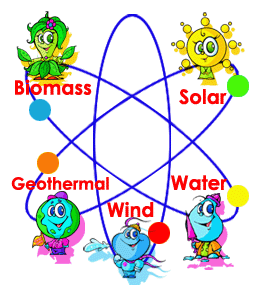|
|
Renewable
energy
Renewable or regenerative
energy it is energy from sources which on human scales are
inexhaustible. The main principle of use of renewable energy
consists in its extraction from processes constantly
occurring in an environment and granting for technical
application.
Streams of renewed energy which
the person can use occur from various primary sources:
-
Thermonuclear synthesis of
the Sun
-
Radioactive disintegration
of terrestrial elements
-
Movement of space bodies,
in particular rotation of the Earth about the axis
On the Earth energy from these
primary sources is shown in the form of a wind power, hydro
power, a tidal energy, a sunlight, geothermal energy and bio
energy.
The use of renewable energy is
not new. 120 years ago, wood supplied up to 90% of our
energy needs.
Historically, low fossil fuel
prices, especially for natural gas, have made growth
difficult for renewable fuels.
|
In 2006, about 18 percent of
global final energy consumption came from renewable sources,
with 13% coming from traditional biomass, like wood-burning.
Hydropower was the next largest renewable source, providing
3%, followed by hot water/heating which contributed 1.3%.
Modern technologies, such as geothermal, wind, solar, and
ocean energy together provided some 0.8% of final energy
consumption. The technical potential for their use is very
large, exceeding all other readily available sources.
Thermonuclear synthesis of the
Sun is a source of the majority of kinds of renewable
energy, except for geothermal energy and a tidal energy. By
calculations of the astronomers, the remained life
expectancy of the Sun makes about five billions years so on
human scales of the renewable energy occurring from the Sun,
the exhaustion does not threaten.
In strictly physical sense
energy does not renew, and is constantly withdrawn from the
above-named sources. From a solar energy arriving to the
Earth, only very small part is transformed to other forms of
energy, and the biggest part simply leaves in space.
Extraction of mineral energy
carriers, such as coal, oil, natural gas or peat is opposed
to use of constant processes. In wide understanding they too
is renewable, but not to measures of the person as their
formation demands hundreds millions years, and their use
passes much more quickly. |
 |
Renewable energy technologies
are sometimes criticized for being unreliable or unsightly,
yet the market is growing for many forms of renewable
energy. Wind power has a worldwide installed capacity of
74,223 MW and is widely used in several European countries
and the USA. The manufacturing output of the photovoltaics
industry reached more than 2,000 MW per year in 2006, and PV
power plants are particularly popular in Germany. Solar
thermal power stations operate in the USA and Spain, and the
largest of these is the 354 MW SEGS power plant in the
Mojave Desert. The world's largest geothermal power
installation is The Geysers in California, with a rated
capacity of 750 MW. Brazil has one of the largest renewable
energy programs in the world, involving production of
ethanol fuel from sugar cane, and ethanol now provides 18%
of the country's automotive fuel. Ethanol fuel is also
widely available in the USA.
While there are many large-scale renewable energy projects,
renewable technologies are also suited to small off-grid
applications, sometimes in rural and remote areas, where
energy is often crucial in human development. Kenya has the
world's highest household solar ownership rate with roughly
30,000 small (20–100 watt) solar power systems sold per
year.
Climate change concerns coupled with high oil prices, peak
oil and increasing government support are driving increasing
renewable energy legislation, incentives and
commercialization. EU leaders reached agreement in principle
in March 2007 that 20 percent of the bloc's energy should be
produced from renewable fuels by 2020, as part of its drive
to cut emissions of carbon dioxide, blamed in part for
global warming. Investment capital flowing into renewable
energy climbed from $80 billion in 2005 to a record $100
billion in 2006. This level of investment combined with
continuing double digit percentage increases each year has
moved what once was considered alternative energy to
mainstream. Wind was the first to provide 1% of electricity,
but solar is not far behind. Some very large corporations
such as BP, General Electric, Sharp, and Royal Dutch Shell
are investing in the renewable energy sector. |

